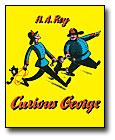Books |
Curious George
By
Published: Jan 01, 2007
Category:
Children
There was no school on Martin Luther King’s birthday, so I asked our daughter — age “four-and-a-half-and-three-quarters” — to pick out some books that I could read to her. She returned with a stack that included H.A. Rey’s “Curious George.” It’s been millennia since my parents read the 1941 classic to me, so I was pleased to be reading about the little monkey.
Not for long.
Maybe it was just a matter of reading the wrong book on the wrong day….but let me tell you the story of the first book in the “Curious George” series from the point-of-view of a reasonably aware white parent in 2007.
First, in case you don’t have a kid handy who loves this character, here’s a plot summary:
A monkey playing happily in a tree in his African homeland is spotted by a white man in a large yellow hat. The man puts the hat on the ground; George comes down from the tree to try it on. It’s too big — so he doesn’t see the white man approach, Next thing George knows, he’s been popped in a bag and on a ship bound for America. A few adventures later and the monkey is in New York. At the white man’s apartment, he drinks wine, smokes a pipe and wears pajamas. The next morning, he accidentally calls the fire department — and is put in prison for phoning in a false alarm. He escapes, is reunited with the white man and — at last — is brought to the zoo, where he lives happily with other African animals.
Now here is the story as it revealed itself to me:
A black man, living happily in his African homeland, is tricked by a white man dressed like an English lord. Without asking about his family or his preferences, the white man shackles the black man and takes him on a slave ship to America. In the city, the black man causes a minor bit of trouble and is thrown in prison, where he gets no lawyer and has no rights (think: Guantanamo). At book’s end, he is uncaged, but hardly free — he’s the very cliche of the black entertainer, a minstrel who will always grin and shuffle for his white “massuh.”
Okay, I understand that “Curious George” was written in another time, when sensitivities aren’t what they are now. But my interpretation seemed so obvious — colonialism and cultural imperialism are hardly subtle — that I poked around to see if others had noticed what I did.
On Barnes&Noble.com and Amazon.com, I mostly encountered nostalgia: Parents who grew up on “Curious George” were happily introducing their kids to the monkey. Only one Amazon reviewer pointed out that George smokes a pipe and sniffs a bottle of ether.
I next looked into the biographies of the authors, to see if they harbored racist attitudes. It turns out that Hans Rey and his wife Margret were both German Jews, They met in Brazil, married in 1935 and moved to Paris, where they wrote the first of the Curious George books. In 1940, they correctly assessed the German threat and jerry-rigged two bicycles. They loaded their bikes with only their coats and five manuscripts and pedaled to the Spanish border, where they traded their bikes for steamer tickets and made their way to Brazil, then New York. In l941, “Curious George” was published in America.
Interesting, I thought, that the Reys duplicated the America-bound passage of their fictional monkey. Only in their case, they weren’t rescued by a benign colonialist, they were fleeing a monster. In New York, they didn’t get in trouble; they got famous. I find their escape from the Nazis noble and exciting and dangerous; I can understand why George’s exile might seem warm and fuzzy to them. And why they saw nothing but fun in their little book.
Maybe it’s me. Maybe I look too deeply into simple stories these days. Maybe a reader like me is, in his heart, a prosecutor who is always eager to be offended. But on the very afternoon I came to my revelation about “Curious George,” I went out and bought Flotsam, which strikes me — and the little one — as about ten times more interesting than “Curious George.” And yet, there’s nothing in “Flotsam” that feels “correct.”
So why I am linking to the “Curious George” book and DVD? Because my job is to opine, not to censor. George is a beloved figure. And it gives parents a special pleasure to share a childhood favorite with their kids, And — it’s happened before — I may just be wrong about what these books signify. Sometimes a monkey is just a monkey.
To buy “The Complete Adventures of Curious George” from Amazon.com, click here.
To buy just the first “Curious George” book from Amazon.com, click here.
To buy the DVD of the 2006 film, “Curious George,” from Amazon.com, click here.


